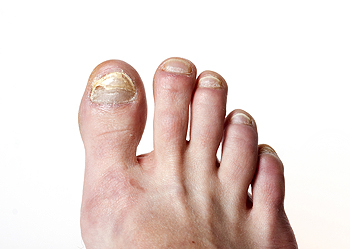Blog
Items filtered by date: December 2022
Who Gets Toenail Fungus?

Toenail fungus can become painful and turn into an infection. This condition usually starts as white or yellowish spots on the tips of the toenails, eventually causing unsightly thickening, discoloration, and crumbling. Anyone can get toenail fungus, but some populations are more at risk than others. For example, those over 60 are more apt to suffer from this condition because as they age, their nails become drier, more brittle and cracked and fungi can sneak through. Those who sweat more than usual have a prime breeding ground for toenail fungus. Wearing tight shoes and thick socks can make feet sweat more and invite fungus to grow inside. If one has had toenail fungus before, there is a high likelihood of getting it again. Walking barefoot in humid and wet public places, such as swimming pools or locker rooms, can cause toenail fungus to spread. If you have signs of toenail fungus, seek the counsel of a podiatrist as soon as possible so that the condition will not worsen or spread to others.
For more information about treatment, contact Stephanie Tine, DPM of Flamingo Foot and Ankle. Our doctor can provide the care you need to keep you pain-free and on your feet.
Toenail Fungus Treatment
Toenail fungus is a condition that affects many people and can be especially hard to get rid of. Fortunately, there are several methods to go about treating and avoiding it.
Antifungals & Deterrence
Oral antifungal medicine has been shown to be effective in many cases. It is important to consult with a podiatrist to determine the proper regiment for you, or potentially explore other options.
Applying foot powder on the feet and shoes helps keep the feet free of moisture and sweat.
Sandals or open toed shoes – Wearing these will allow air movement and help keep feet dry. They also expose your feet to light, which fungus cannot tolerate. Socks with moisture wicking material also help as well.
If you have any questions please feel free to contact our office located in Fort Lauderdale, FL . We offer the newest diagnostic tools and technology to treat your foot and ankle needs.
What Is an Ingrown Toenail?

An ingrown toenail is one of the most painful foot conditions to have. It happens when the nail grows into the skin instead of over it. This can happen for various reasons including wearing shoes and socks that are too tight, cutting the toenail incorrectly, and possibly from a toe injury. Some patients develop an ingrown toenail because of the shape of the nail or from poor foot hygiene. Diabetic people may be prone to ingrown toenails because of reduced blood flow to the feet. Additionally, experiencing toenail fungus frequently may lead to an ingrown toenail, and this can cause the nail to become brittle and put pressure on the surrounding skin. Many people are unaware that having poor posture may put extra weight on the toes too, therefore increasing the chances of getting an ingrown toenail. If you have existing or recurring ingrown toenails, it is strongly suggested that you consult a podiatrist who can offer you relief and treatment techniques.
Ingrown toenails can become painful if they are not treated properly. For more information about ingrown toenails, contact Stephanie Tine, DPM of Flamingo Foot and Ankle. Our doctor can provide the care you need to keep you pain-free and on your feet.
Ingrown Toenails
Ingrown toenails occur when a toenail grows sideways into the bed of the nail, causing pain, swelling, and possibly infection.
Causes
- Bacterial infections
- Improper nail cutting such as cutting it too short or not straight across
- Trauma to the toe, such as stubbing, which causes the nail to grow back irregularly
- Ill-fitting shoes that bunch the toes too close together
- Genetic predisposition
Prevention
Because ingrown toenails are not something found outside of shoe-wearing cultures, going barefoot as often as possible will decrease the likeliness of developing ingrown toenails. Wearing proper fitting shoes and using proper cutting techniques will also help decrease your risk of developing ingrown toenails.
Treatment
Ingrown toenails are a very treatable foot condition. In minor cases, soaking the affected area in salt or antibacterial soaps will not only help with the ingrown nail itself, but also help prevent any infections from occurring. In more severe cases, surgery is an option. In either case, speaking to your podiatrist about this condition will help you get a better understanding of specific treatment options that are right for you.
If you have any questions please feel free to contact our office located in Fort Lauderdale, FL . We offer the newest diagnostic and treatment technologies for all your foot and ankle needs.
Blog Archives
- April 2025
- March 2025
- February 2025
- January 2025
- December 2024
- November 2024
- October 2024
- September 2024
- August 2024
- July 2024
- June 2024
- May 2024
- April 2024
- March 2024
- February 2024
- January 2024
- December 2023
- November 2023
- October 2023
- September 2023
- August 2023
- July 2023
- June 2023
- May 2023
- April 2023
- March 2023
- February 2023
- January 2023
- December 2022
- November 2022